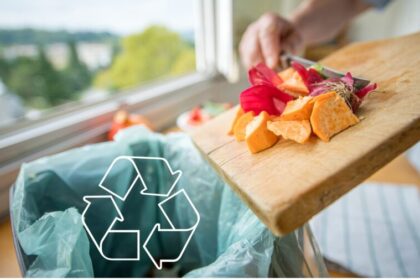What is a circular economy?
When thinking of the economy, most people think of money and economics. However, the economy includes much more than dollar bills and how much the government spends. In fact, there can be more than one type of economy, such as an environmental economy. The environmental economy has two specific types: circular and linear.
A linear system, or linear economy, involves sending materials in one direction – essentially a straight line with no return (plantchicago) – hence the name, linear economy. Usually, the deposit site is a landfill or the environment, which can result in harmful impacts on people, animals, and the environment as a whole. According to Plant Chicago, the linear process is commonly referred to as the “take, make, dispose” process.
A circular economy is defined by Plant Chicago as, “a collaborative economic practice sustained by local circulation of materials, nutrients, knowledge, and money” (plantchicago). Instead of the phrase “take, make, dispose”, a circular economy focuses on “transparency, diversity, and inclusion.” The three main goals of this process are to eliminate pollution and waste, circulate products and materials, and to regenerate nature (ellenmacarthurfoundation).
How can we visualize these systems?
Currently, plastics are produced from fossil fuels. We know there is plastic pollution in the environment. Our waterways and oceans have been compromised because of the linear system. According to a 2019 article, around 6.3 billion metric tons of plastic produced in our planet has resulted in waste. We didn’t prepare to re-capture these materials, instead people changed their habits and started to dispose things without thinking about the impact it will have in our lives 50 years later.
In a circular economy system, one example is cut down waste by eliminating food waste. As of now, many places such as restaurants and grocery stores have to throw out food without warning to the public. In Scandinavia there is a startup app named Too Good To Go that helps restaurants and grocers alert the public of food that needs to go for a discounted price (tomranewsroom). Another way business’ have implemented a circular economy is by composting the organic waste. Diverting organic waste through a commercial compost hauler could generate a new product that enriches the quality of soil. This choice generates 25 times less CO2 compared to the landfill option.
Companies have been able to collaborate during the Covid-19 pandemic and make the idea of repurposing food items a reality by creating vinegar from beer (specialityfoodmagazine). The same idea is used when we recycle plastic – which is another way to participate in a circular economy. If we use a circular economy properly, it will help us resolve the issue of using too many non-renewable resources and focus on using renewable resources instead, such as plant based materials. Some grocery stores have a drop bag location to capture flexible packaging from consumers. These bags have a recycling number 2 or 4, respectively, which can be recycled to produce new products.
How can you implement a circular economy in your business?
If you think about it, in the long run, we have the influence to make change happen. People have continuously changed history and the way things are done, but the first step in each change is educating those around us. MB Consulting joined Plant Chicago last year as a member of the CELN (Circular Economy Leaders Network). This was a great opportunity to learn more about circular economy practices. Small businesses can implement them to lower their environmental impact, and find partnerships and collaborations with other members. MB Consulting provides sustainable packaging education and training to local restaurants, growers and independent retailers. The goal is to implement circular economy projects around packaging. By sourcing responsibly, businesses can invest their dollars in solutions that are truly recyclable, compostable or re-usable.
What is the role of packaging sustainability in a circular economy?
In our CELN group, we noticed that many businesses involved had a keen interest of packaging sustainability. When businesses are focused on building a sustainable brand, packaging is a major component in this effort. Small food manufacturers have the challenge to select food packaging that will ensure optimal shelf life and quality of their products. It takes time and effort to source, trial new materials and analyze the information to find a suitable sustainable solution. Sometimes, packaging sustainability starts with a strategy of material reduction. Small businesses phase another challenge which is economies of scale. When they don’t have the minimum volumes required to do custom printing, they typically need to apply labels to their packaging. We discussed the issues around mixing materials on a previous Blog. So helping businesses use best practices through sustainable sourcing is an important strategy towards implementing a circular economy.
Why is educating the community on circular economy so important?
We plan on partnering with local organizations to train local restaurants on more sustainable packaging materials to advocate for packaging circularity. The State of Illinois is working on environmental bills, and one of the items on the table is the ban of Styrofoam single use plastic. This has been proposed before, but the pandemic hit and restaurants were greatly affected by this. However, Styrofoam has already been banned from other States, and our community needs to be prepared. We have noticed that some demographics are more reactive than proactive. We think it is important to provide valuable information to the restaurant and foodservice community, so they can be better prepared with new options and perhaps suppliers. The supply chain has been disrupted during 2021, and this situation will remain an issue through 2022. An empowered community can face these challenges with more confidence and preparedness.
Is collaboration a successful strategy to achieve a circular economy?
There needs to be collaboration amongst stakeholders and anyone else involved with your business. In order to implement successful strategies to better your business and the surrounding environment, everyone involved needs to coordinate with one another. However, sometimes you will need to collaborate with people in higher positions, such as the government, to get laws and regulations passed to help you. For example, if we want to have better recycling plans and better waste strategies for Chicago, it is not something simple that we can start ourselves. Instead, we will need to talk to local government officials about improving the city’s waste management strategies. Another example of collaboration is between businesses. A company selling products in a reusable container can work with a zero waste retailer. MB Consulting will be collaborating with clients on strategies to close the loop of compostable and recyclable packaging.
Conclusion
Although a circular economy can seem like a challenging and time consuming thing to do, we believe it is worth the effort. Particularly if this involves a community affair, in which the burden is shared with others. We are excited for the goals we have set up for 2022 through our CELN membership, and for the educational programming we are working on with our community partners.
Email us at info@mbconsultingus.com if you want to learn more about our experience as CELN members, help you visualize and implement circular economy opportunities for your small business, or if you have a referral you would like us to work with.
References
https://www.plantchicago.org/circular-economy
https://ellenmacarthurfoundation.org/topics/circular-economy-introduction/overview
https://www.specialityfoodmagazine.com/retail/circular-economy-food-and-drink




